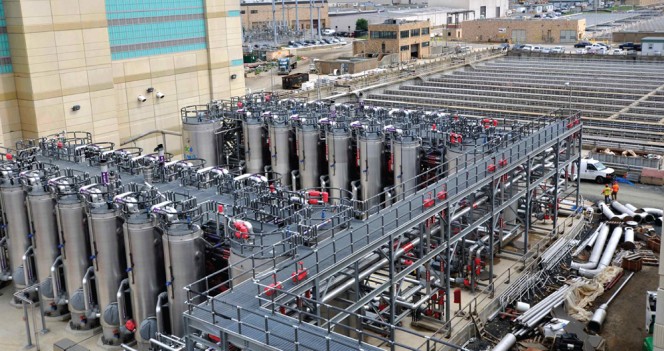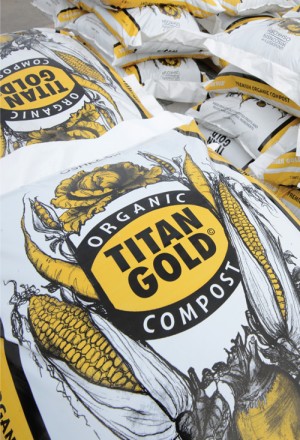BioCycle October 2015
Oshkosh, Wisconsin: University AD Plant Boosts Revenues With Compost, Heat Sales
By producing compost from its digestate, collecting tipping fees and expanding use of its thermal heat, the University of Wisconsin, Oshkosh (UWO) expects to maximize the revenue potential of its industrial-scale dry fermentation anaerobic digester (AD) that began operating in 2011. In late July, UWO launched Titan Gold, an OMRI-certified organic compost product that is approved by the US Composting Council’s Seal of Testing Assurance program. “The digester has been running continuously for the last few years with no problem, but it is not profitable producing just 375 kW electricity at maximum capacity, so that’s why we set up the composting,” notes Greg Kleinheinz, Viessman Chair of Sustainable Technology, Director of the Environmental Research and Innovation Center (ERIC) Lab. The dry digester takes in approximately 200 tons/week, or 10,000 tons/year of food scraps (48% of total), yard trimmings (17%) and farm residue (35%, consisting of bedding, straw, crops, some manure), says Brian Langolf, UWO’s director of biogas systems. To make Titan Gold, the dry digestate is taken to Zillges Materials, about 15 minutes from campus, where it is mixed with yard trimmings in a 1:3 ratio. Zilges composts in outdoor windrows aerated with a pull-behind turner. Material is composted and cured in about 16 weeks. It is bagged on campus using the university’s new bagging operation.
During the winter months, the digestate is stored, and then composting starts again in the spring. “We have outdoor storage, and expect to store maybe 5,000 to 6,000 tons over the winter,” adds Kleinheinz. “Next year will be our first full year of production.” The university hopes Titan Gold will be sold at nurseries and landscape centers next spring for $14.99/cubic foot. Revenue from Titan Gold sales will go to student activities, including scholarships and employment, and be administered by the university’s foundation. UWO students sell the compost at area farmers markets. Biogas from the digester is fed into a 370-kW 2G Cenergy CHP system, which has a capacity of 3,071 MW of electricity annually and 474 kWh thermal. The system is running at approximately 70 percent efficiency for electrical generation, notes Langolf. Power is sold to Wisconsin Public Service under a power purchase agreement. The CHP engine is oversized because it also takes in any excess biogas produced by an adjacent wastewater treatment plant. Excess thermal energy will be sold to a neighboring building once the connection is installed this fall. “Heat utilization and compost sales is what brings us full circle,” adds Langolf. Overview video of the UWO dry digester operations.
Portland, Oregon: Climate Trust Funding For Biogas Projects
The Climate Trust received a $1 million Conservation Innovation Grant from the U.S. Department of Agriculture (USDA) to launch an investment fund to finance biogas, forestry and grassland conservation projects. To leverage this support, The Climate Trust is raising at least $4 million in private capital to invest in projects based on the anticipated value of the carbon credits they will generate. It will be available to farmers, ranchers, and forest owners to mitigate and sequester carbon emissions through proven conservation practices. “This significant award from the USDA is a key ingredient in our plans to leverage our existing programs to attract private capital and amplify our impact,” explains Peter Weisberg, program director for The Climate Trust. “The vital projects we’re looking to fund depend upon revenues from carbon markets to come to fruition. Collectively, these projects could make a big climate impact.” In addition to making investments to overcome the financial barriers these projects face, the fund will help projects generate and sell carbon offsets in voluntary and compliance carbon markets. The proceeds from the sale of these credits will be used to repay investors in the climate investment fund. Remaining margins will be shared with producers and revolved into future conservation investments.
Sacramento, California: Food Waste Digester Expansion
In July, CleanWorld completed a major expansion of its high solids Sacramento Biodigester, located at the city’s South Area Transfer Station. The facility added two steel tanks — 300,000 gallons and 600,000 gallons — quadrupling processing capacity from 25 tons to 100 tons/day of primarily food waste streams. The tanks were supplied by Pacific Tank Solutions. CleanWorld CEO Michele Wong says the firm anticipates the expanded system will be operating at full capacity by year’s end. A rapidly increasing flow of organic waste is anticipated due to the State of California’s recent implementation of Assembly Bill 1826, which requires commercial businesses to start recycling organics. “With a higher level of diversion required, more people are looking for outlets for their organic waste,” Wong notes. Along with organics collected by the City of Sacramento Waste Authority, the facility also processes material from nearby cities and county agencies, such as the Western Placer (County) Waste Management Authority. Wong says the facility also recently began servicing two large grocery chains.
The Sacramento biodigester officially opened in January 2013, but all components of the operation didn’t come on line until five months later. CleanWorld operates the digester under a 20-year lease with the county. Atlas Disposal, a Sacramento-based waste hauler, installed a BioCNG fueling station adjacent to the digester to utilize the renewable compressed natural gas (CNG) for its fleet. A portion of the biogas — about 300 scfm/day (about 1,400 diesel gallon equivalents) — is being converted to fuel 30 trucks in Atlas’ growing fleet with CNG engines. CleanWorld purchased a BioCNG 100 biogas conditioning system that also compresses the gas to send to the Atlas fueling station. The BioCNG system includes hydrogen sulfide, VOC/siloxane and carbon dioxide removal, and chilling. Atlas’ fueling station stores conditioned biogas in two low-pressure 250 psi vessels, before it is compressed to 4,500 psi for fueling. Atlas is adding more CNG trucks to its fleet as existing ones are decommissioned due to age, according to Sean Moen, general manager of Atlas ReFuel. “Our drivers like it because (the CNG-powered trucks) are very quiet. And, it’s been great for reducing our carbon footprint.” Atlas has formed a subsidiary to sell excess CNG to about a dozen other companies with CNG vehicle fleets, including street-sweeping companies, taxi and shuttle operators and security firms.

DC Water’s hydrolysis-anaerobic digestion project at the Blue Plains Advanced Wastewater Treatment Plant
Washington, DC: DC Water Unveils Hydrolysis, AD Facility
DC Water unveiled its $470 million hydrolysis-anaerobic digestion project in early October that is producing a net 10 MW/hour of electricity, providing about one-third of the power needed to operate the Blue Plains Advanced Wastewater Treatment Plant, which has capacity of 370 million gallons per day. The new facilities include a dewatering building, 32 thermal hydrolysis vessels, four concrete 80-foot high anaerobic digesters that hold 3.8 million gallons of solids each and three turbines the size of jet engines. The project uses the CAMBI® thermal hydrolysis process (THP) that employs high heat and pressure to kill pathogens in the biosolids and break them down so they are more readily digested. In addition, according to CDM Smith, DC Water’s consulting engineers for the project, “THP allows higher loading to the digesters, reducing the required retention time and the corresponding digester volume. It also improves the reduction of volatile solids in the digesters, resulting in higher gas production compared to conventional digestion.” Steam produced by the turbines is captured and directed back into the process. Class A biosolids are produced, and are currently being used around the District for urban gardens and green infrastructure projects.
Albany, New York: $175 Million For Five Large-Scale Clean Energy Projects
New York Governor Andrew Cuomo announced $175 million in awards for five large-scale clean energy projects that will help the state meet its Reforming the Energy Vision goals to increase the amount of electricity generation from renewable energy sources. Once operational, the five projects will add approximately 116 MW of new renewable capacity, which will provide about 356,000 megawatt-hours per year of clean renewable energy to New York — enough to supply over 54,000 average-sized homes per year. Funded projects include a 100 MW wind farm in western New York; a 9.6 MW anaerobic digestion biogas-to-electricity facility in Staten Island, being developed by Orbit Energy NYC, that will use food waste and other organic materials provided by area restaurants, supermarkets and food manufacturers; a 5.2 MW addition to an existing hydroelectric facility resulting in a total installed capacity of more than 11 MW; a 790 kilowatt (kW) fuel cell in Morgan Stanley’s Manhattan offices that willl contribute to load reduction, system reliability and cleaner electric power; and a new 560 kW minimum flow turbine at a hydroelectric facility in Oswego County. Reforming the Energy Vision (REV) is Cuomo’s strategy to build “a clean, resilient and affordable energy system for all New Yorkers, transforming New York’s energy policy with new statewide initiatives and regulatory reforms,” according to the Governor’s office. REV places clean, locally produced power at the core of New York’s energy system.













